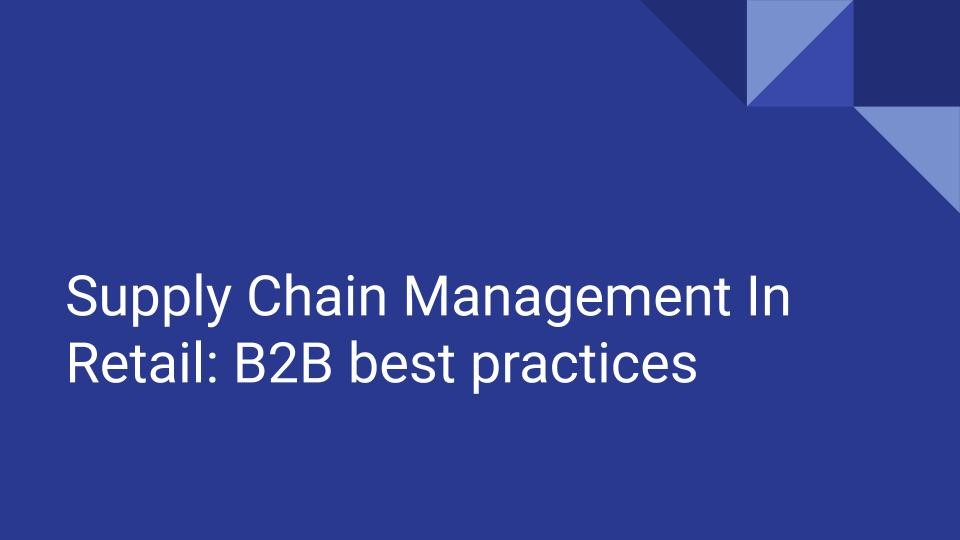
In today’s retail world, one of the best ways to grow and sustain your business is via a sustainable supply chain. As supply chain management becomes more important, it is always beneficial to a business to ensure that it is on the platforms where its customers and suppliers are clearly visible.
There is always room for improvement, and the solution to current retail activities in business e commerce activity and beyond is via the utilization of supply chain management. Organizations that have committed to the utilization of supply chain management, have managed to secure sustainable growth via the strategies that are outlined in this guide. Designed to be customized to your organizational needs, the ability to fill the gaps in your retail activities and actually free your operations team to work on future projects, enables your current product and service offerings to find the pipeline to their ultimate customer base.
The pandemic has taught us the importance of a robust supply chain. The odds of profitability being impacted by stock outs is quite high in this current regime. The retail sector is one of those industries where stock management is highly critical. With impacts from online enterprises such as Amazon, retail companies have to rethink their current supply chain management strategies in order to remain in business. Retailers have to manage products across multiple channels, manage their inventory, coordinate with their supply chain and connect with their customers. The key to a successful retail year is a robust supply chain.
The retail supply chain involves the coordination of business transactions involving goods and services. The key in retail is understand what customers will want in a given season, and have that on hand. As an inventory intensive industry, cash flow will be dependent on the ability of the retailer to actually anticipate what the customer will need. While events like Black Friday will increase the volume of sales that take place in the store, the rest of the year is when the baseline profitability of the organization will have to be earned.
Customer products are the outcome of an effective supply chain. Retailer cost management, in order to meet the customer’s needs at the right price, is highly correlated to cost and delivery management. With tighter control of inventory levels and an effective distribution plan, an organization can actually give itself a competitive advantage in its particular market.
SUPPLY CHAIN BEST PRACTICES
-
Have a leadership strategy centered on the supply chain
Every organizational function will benefit from good leadership and a vision. As an organization, it will be important to ensure that you have a responsible person who will manage a team of people whose specialty is the supply chain. This team will focus on all aspects of the supply chain, and propose and find solutions as they arise. The team will prove to the management the value of an organized supply chain.
-
Have adequate capacity management in the supply chain
Supply chain management in an inventory based business will benefit from having the right amount of staff, and also benefit from having adequate support such as robots operating in the background. With supply chain management, it is important to have the right goods, in the right place, in the hands of the right people. With properly trained staff who understand how they fit into the supply chain, the business will actually operate smoothly.
-
Apply Industry 4.0 Standards
Automation is one of the key ways that a retail based organization can improve its capability. With adequately organized workflows and processes that are technology driven, the success of the supply chain can be managed. Utilizing the human capital in order to focus on either customer engagement or with strategic planning, will be key to successful supply chain management.
-
Healthy Supplier Relationships
Retailers thrive on suppliers for their business operations. With successful supplies, stock management is easier, and customers will have options to actually incorporate into their shopping experiences. With two way communication between the customer (retailer) and supplier (wholesaler) the best deals can be negotiated.
-
Be strategic in your sourcing plan
If the pandemic has taught us anything, it is to build redundancy into our operating systems. Include multiple suppliers for products in your recovery plan, in the instance that you are affected by your primary source. If one supplier has a delivery issue, you can then initiate the supply from your alternate source and still achieve the objective of meeting your customer’s needs.
Logistics is a multifaceted activity, and it will be important for a retailer to understand the current process flows that are involved in the current supply chain. Finding the weaknesses, and enabling the organization to actually take the time to figure out to solve the problem if there’s a supply chain breach, will be the key to success in retail.
